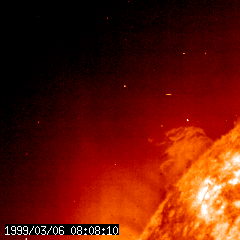Saturday, June 21, 2008
Tuesday, June 17, 2008
"really making the case that we live in a crowded universe"










Astronomers find 'super Earths' circling a star
6/16/2008, 6:33 p.m. EDT
By SETH BORENSTEIN
The Associated Press
WASHINGTON (AP) — European astronomers have found a trio of "super-Earths" closely circling a star that astronomers once figured had nothing orbiting it, demonstrating that planets keep popping up in unexpected places.
Monday's announcement is the first time three planets close to Earth's size were found orbiting a single star, said Swiss astronomer Didier Queloz. He was part of the Swiss-French team using the European Southern Observatory's La Silla Observatory in the desert in Chile.
The mass of the smallest of these super-Earths is about four times the size of Earth. That may seem like a lot, but they are quite a bit closer in size and likely composition to Earth than our solar system's giants — Jupiter, Saturn, Uranus and Neptune. They are much too hot to support life, Queloz said.
Scientists are more interested in the broader implications of the finding: The universe is teeming with far more planets than thought.
Using a new tool to study more than 100 stars once thought to be devoid of planets, the Swiss-French team found that about one-third had planets that are only slightly bigger than Earth.
That's how the star with three super-Earths, 42 light-years away, was spotted. The European team took a second look with a relatively new instrument that measures tiny changes in light wave lengths and is so sensitive that it is precisely positioned and locked in a special room below the observatory in Chile. And the key is kept in Switzerland, scientists say.
The discovery is "really making the case that we live in a crowded universe," said Carnegie Institution of Washington astronomer Alan Boss, who wasn't part of the discovery team. "Planets are out there. They're all over the place."
That means it is easier to make the case for life elsewhere in the universe, both Boss and Queloz said.
___
On the Net:
The European Southern Observatory: http://www.eso.org/public/
© 2008 Associated Press. All Rights Reserved.
Subscribe to:
Comments (Atom)

